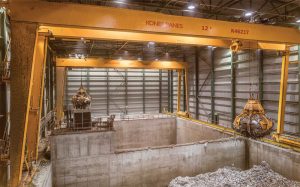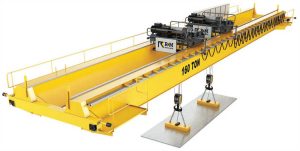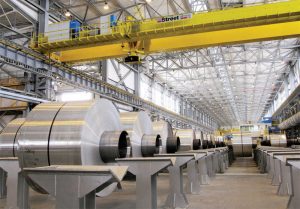Heavy-duty, high capacity process cranes are being engineered to offer greater levels of safety and operational flexibility, reports Tom Woerndl.
- Finland-based Konecranes has teamed up with the Riikinvoima waste-to-energy plant in the east of the country to supply two 12t hoists.
- Ohio, US-based R&M Materials Handling is currently working on a project to supply a high-output crane to a steel manufacturing facility in Regina
- SCX Special Projects recently supplied process cranes to a UK paper mill and an aluminium plant in Oman.
It’s important to have the right crane for the job—so when the goal is to repeatedly move non-breakable, mass substances at high volumes and for long time periods, operators will often have reliability, durability, and safety at the forefront of their minds.
Customers are also increasingly demanding more bespoke solutions that are engineered precisely to their demands, and may use technology sourced from a range of suppliers, but delivered and installed by just one company.
An industry that often requires process cranes is metal processing. Ohio, USbased R&M Materials Handling is currently working on a project in this sector, supplying a high-output crane to a steel manufacturing facility in Regina, Canada.
The multi-crane installation at the brand new Varsteel facility in Saskatchewan features a 50USt DXW heavy-duty wire rope hoist that will load and unload full plate steel.
“This is a fast, high-capacity hoist that will be operating twenty-four hours a day, so it has to be both reliable and durable,” explains Kevin Towers, regional sales manager at R&M. “We’ve been working on this project for about 18 months, and we’re now ready to ship components to our crane manufacturing partner in Canada.”
Pinnacle Industrial Services will be constructing the crane, with Towers expecting installation in February 2020. “The customer said to us that they’d had problems in the past with the durability of their cranes, and as a result we have focussed on the long-term reliability of the hoist, as well as ensuring that spare parts would be readily available to limit downtime,” he adds. “This was a major factor for Varsteel, as spare parts are not usually stored for this type of crane. The control system for this hoist has also been engineered to ensure smooth and precise location of loads.”
The hoist, which will be the first DXW model installed in Canada, follows similar projects in the US, several of which have exceeded 125USt.
DXW is an open winch electric overhead hoist that includes extra-hard wheels with MCB-type bearings, said to extend the lifetime of the runway and wheels, and a DC disc hoist motor brake with 200% braking torque.
In addition, the technology features an overload limiter with built-in condition monitoring, to help safe operation and enable predictive maintenance monitoring.
“There is a huge potential for future sales for this type of crane,” says Towers. “Generally, for projects like this, equipment is sourced individually by the customer, which can lead to Frankenstein-type cranes, with drives, festooning and controls all supplied by different companies.
“However, we’re delivering a new concept and acting as a single source for customers, which ensures that the crane fits together and works effectively, while making it easy for client communication and sourcing of spare parts. We’ve set a new pattern for process cranes and are certain that customers will jump on board.”
In terms of the process crane market as a whole, Towers notes that the steel industry has been demanding the company’s DXW hoist, while the hydroelectric sector has installed a number of SXL cranes.
“These projects are slightly different to the steel industry, as the hoists are moving multi-million dollar turbines, which means that precision is incredibly important,” he notes.
Custom made commonplace
Specialising in bespoke crane installations, SCX (Street CraneXpress) most recently installed two 25t goliath cranes that are operating at a 350m long stockyard in the UK.
“We were asked to replace two ageing manually controlled goliath cranes, the operation of which was causing health and safety concerns,” explains Dave Little, technical sales manager at SCX Special Projects, which is based in Sheffield, England.
“The objective was to remove all manpower from the stockyard, so our solution was to engineer two semiautomated goliath bridge cranes, running in parallel, each with a 35m span and a 25t safe working load.”
The project features a remote control room that houses a number of displays for each crane, including two HMIs for crane diagnostics, stockyard inventory, crane and lifting grapple location and status, plus a multi-screen 14 camera CCTV system to support the crane’s positioning functions.



没有评论:
发表评论